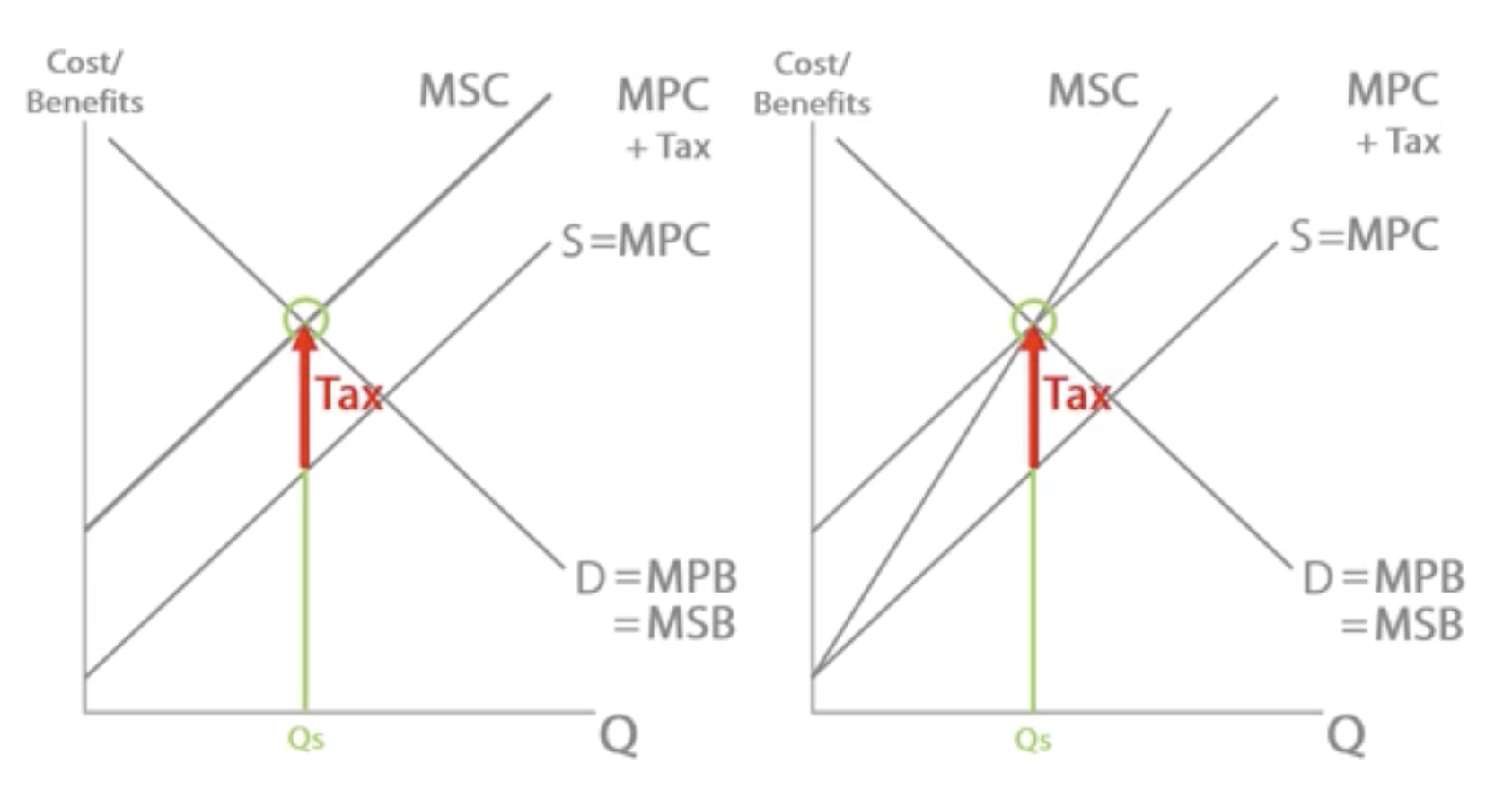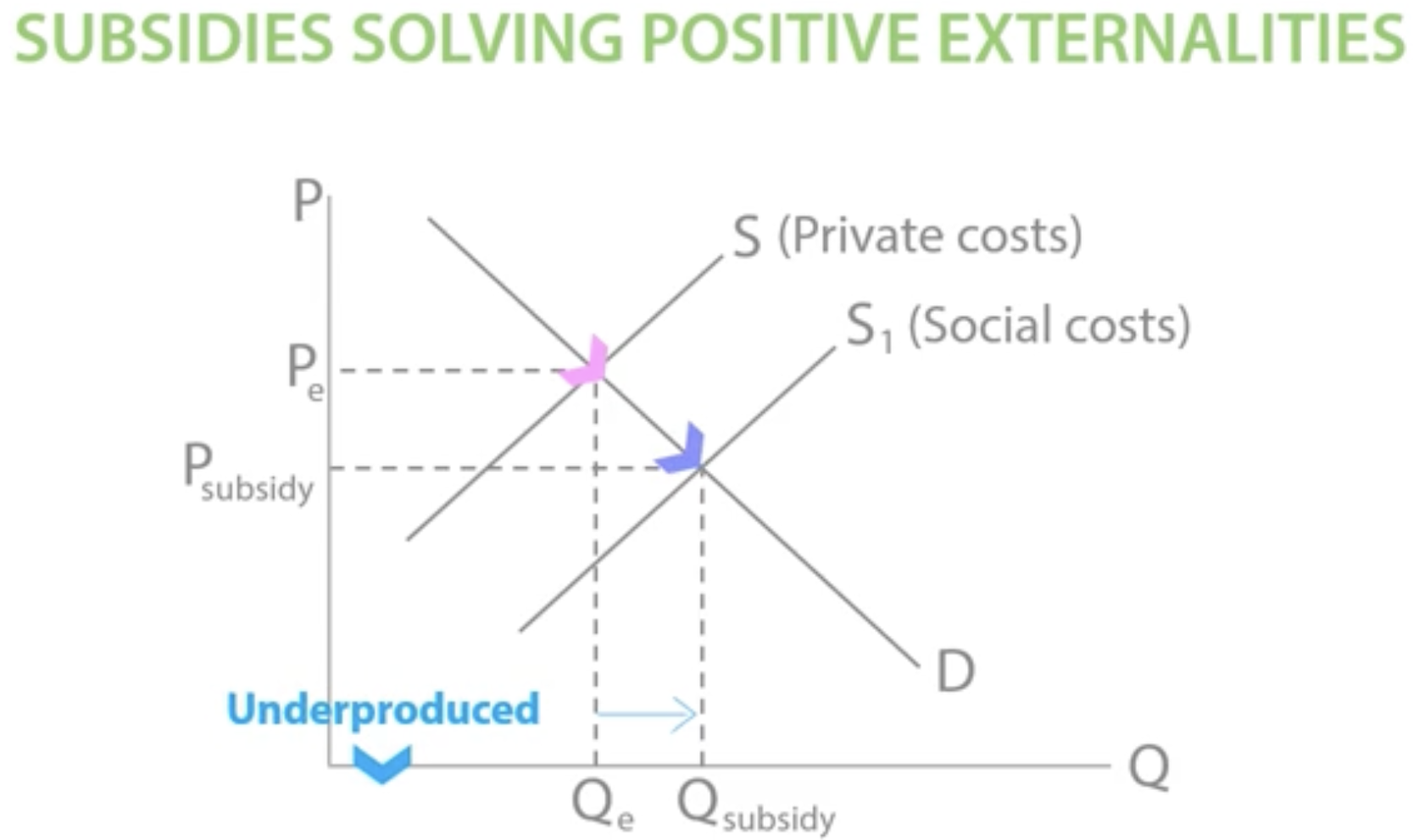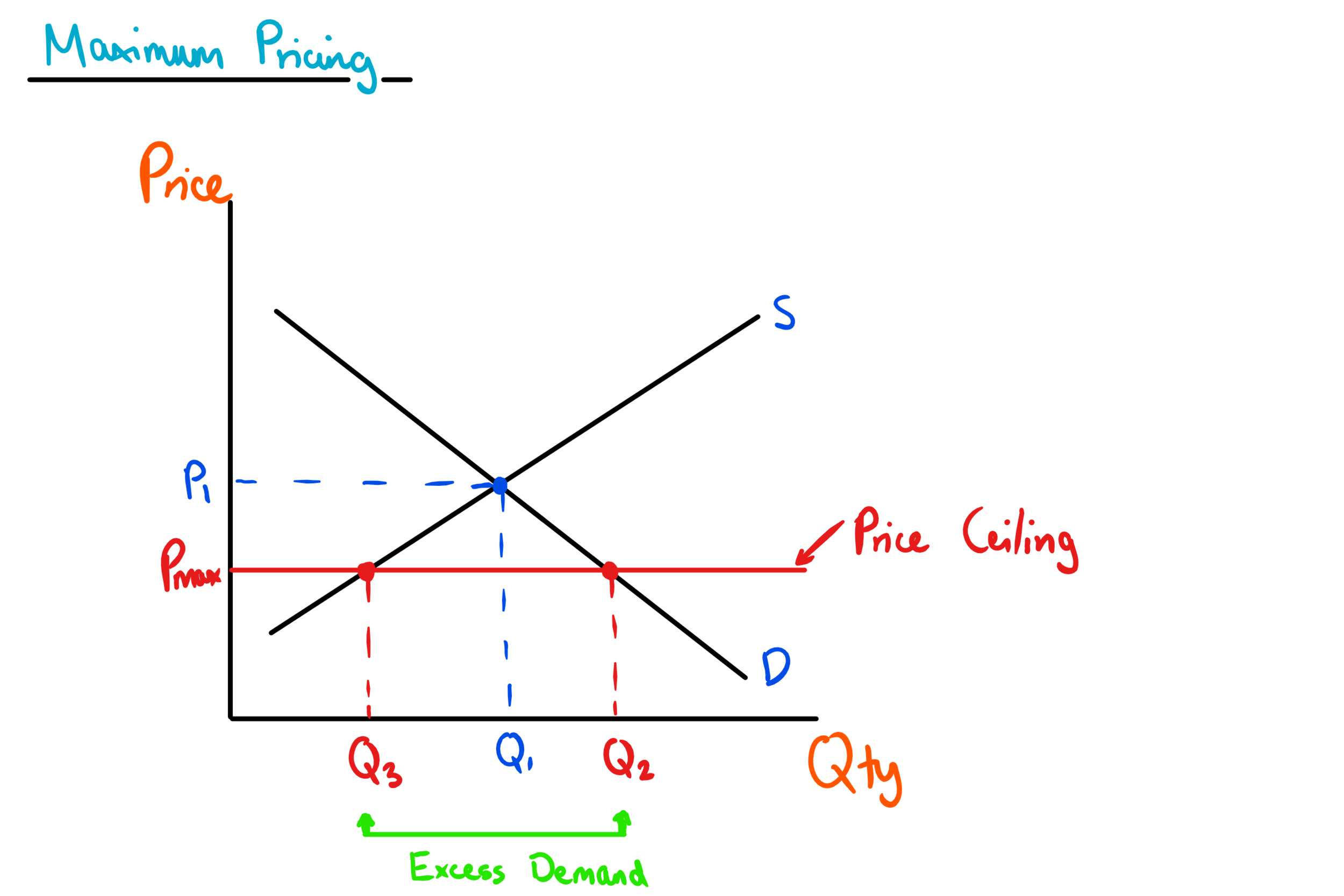1.4 Government intervention
1/14
There's no tags or description
Looks like no tags are added yet.
Name | Mastery | Learn | Test | Matching | Spaced |
|---|
No study sessions yet.
15 Terms
7 methods of government intervention
Indirect taxation
Subsidies
Maximum + minimum prices
Trade pollution permits
State provision of public goods
Provision of information
Regulation
Indirect taxes (to solve negative externalities)
+ISSUES
Increases a firm’s CoP but can tax be transferred to consumers.
Increases CoP → internalises externality (externality is paid for in the price) which moves MPC to MSC → solves overconsumption/ production → promotes allocative efficiency (social welfare is maximised) whilst generating gov. revenue.
ISSUES
Price inelastic demand: Increasing price through tax won’t be responded to by consumers. Quantity may decrease towards social optimum but proportionally less than increase in price.
Setting tax to right level: Assumes perfect info: there may be imperfect info on value of externality to the government. May overtax/ undertax leading to black markets (needs policing + ↓ tax rev.) + regressive taxes (widens income inequality), + externality is not internalised.

Subsidies
SOLVES POSITIVE EXTERNALITIES
Money grant given to producers by the government to lower CoP and encourage an increase in output.
Lowers CoP → decreases price and increases quantity → solves underconsumption/ production → allocative efficiency + welfare gain.
ISSUES
Cost: Larger cost of subsidies, opportunity cost: cost may be cut from gov. revenue towards education, healthcare. Debt interest has to be paid.
Setting subsidy at right level: Assumes gov. have perfect info on value of externality. May under/ over subsidise, so quantity will not reach social optimum. Over-subsidising will increase costs even more + increase firm’s dependency on subsidy.
How will firm use subsidy: May not pass lower costs onto consumers, money used towards paying debts/ savings. Quantity will not reach social optimum (underconsumption).

Price control: min prices (price floors)
SOVES DEMERIT GOODS (info gap) e.g. alcohol in Scotland
The minimum price suppliers of a good can sell for.
-this is so that prices kept high, causing a contraction in demand, reducing overconsumption.
ISSUES
Price inelastic demand: Consumers will not respond to ↑ in price. Quantity will not fall proportionally enough to the social optimum to solve market failure.
Setting min price to right level: Setting too high results in black markets (needs policing + ↓ tax rev.) + regressive nature (widens income inequality), set too low results in Q not being at social optimum.
Price control: max prices (price ceilings)
SOLVES MERIT GOOD (info gap) e.g. energy price cap UK to limit cost of electricity+gas
The maximum price suppliers of a good can sell for.
-prices kept low, causing an expansion in demand, reducing underconsumption.
ISSUES
Shortage: D>S at the max price, so consumers may lose out on the merit good. This creates black markets selling lower quality good for higher price, so consumers do not lose out.
Cost: Costly to increase supply and solve the shortage. Opportunity cost: money can go towards other merit goods.

Regulation e.g. legal age for smoking is 18
Rule/ law enacted by the government that must be followed by economic agents to encourage a change in behaviour.
-needs enforcement of command: bans, limits, caps, compulsory and control: enforcement, punishment (policing)
-gives the incentive to change behaviour → solve issues in free market → allocative efficiency + welfare gain
ISSUES
Cost: administrating + enforcing costs.
Setting the right regulation: determining the right level strictness- may result in unintended consequences + black markets (if too strict).
Tradable pollution permits
SOLVES NEGATIVE EXTERNALITIES
Gov. sets a cap on pollution at socially optimum Q → gov. gives out permits to match cap → firm invests in green tech or buys spare permits → internalises externality or polluter pays in the most efficient way → pollution reduces to social optimum + AE is reached → LR incentive to invest in green tech to increase profit through selling permits + so they’re not burdened when permit price rises.
ISSUES
Cost of enforcement: Level of technology may not be able to accurately measure emissions. Firms need to be monitored to ensure they are adhering to rules.
Imperfect info: Gov. may not be aware of social optimum, so cap may be too tight/ too lacked. Cap too tight may result in unintended consequences like firms shutting down/ leave country due to high CoP or being passed onto consumers via higher prices.
State provision of public goods
SOLVES UNDERCONSUMPTION OF PUBLIC GOODS
Direct provision of goods/ services by the gov. free at the point of consumption.
Gov. allocated resources at socially optimum quantity → free at point of consumption → solves underconsumption/ production and inequity given universal access → solve missing markets → allocative efficiency + welfare max.
ISSUES
Excess demand: gov. can’t ration excess demand, so some can access good + some can’t, leads to larger queues, longer waiting lists e.g. healthcare
Cost: Money to provide public goods may be from higher taxes, cost cuts in certain spending areas, debt interest to be paid, opportunity cost.
Provision of information
SOLVES INFO GAPS
Government funded information provision through adverting, education, to encourage or discourage consumption.
Demand shifts (MPB shifts towards MSB which is socially optimum level) → consumers make rational decisions knowing true MPB → solves under/ over consumption of merit + demerit goods → allocative efficiency.
ISSUES
Costs: Gov. funded- cost cutting in other areas, opportunity cost as there is no guarantee of success if consumers ignore policy or if policy is of poor quality.
LR not SR: Policy will take a while to be taken in by consumers + change their consumption habits. Advertising takes a while to be listened to.
Government failure
When the costs of intervention outweigh the benefits the intervention. The end result is a worsening of the allocation of scarce resources harming social welfare (net welfare loss)
Causes of government failure
Distortion of price signals
Unintended consequences
Excessive administrative costs
Information gaps
Distortion of price mechanism
Distorted prices may not reflect true supply + demand conditions, leading to over/under production of goods + therefore misallocation of resources.
Max prices: Leads to lower prices, reducing incentive to supply + creating excess demand (shortage). Leads to underproduction of goods.
Min prices: Leads to higher prices, creating excess supply, leading to overproduction of goods. e.g. the EU’s CAP for agricultural goods has led to overproduction of wine + dairy products
Subsidies: Leads to lower prices, leading to overproduction of goods. e.g.
Unintended consequences
Consequences may arise due to government overlooking policies + not carefully considering them.
e.g. black markets- may arise due to minimum prices + taxation for goods like cigarettes, impact on poor households- arise due to minimum prices + regressive taxation, impact on firms- may shut down/ decrease in size due to taxation + regulation.
APP: EU fishing quota to reduce overfishing led to fishermen catching as much as possible before quota was reached, leading to surge in fishing activity.
Excessive administration + enforcement costs
Special regulators must be hired to monitor companies in making sure they are adhering to regulations, price controls, etc. The cost of monitoring may end up being more than the benefit gained for putting these in place.
Regulation, subsidies, state provision, price controls.
APP: excessive regulation + bureaucracy led to high admin costs in NHS- divert resources away from core services.
Information gaps
Externalities may not be valued accurately e.g. underestimating costs of cigarettes, resulting in policies that are too strict or too lacked, making it ineffective as costs outweigh benefits.
APP: environmental regulations, due to inadequate info on most significant pollution emitters, led to inefficiencies+failure to achieve goals.